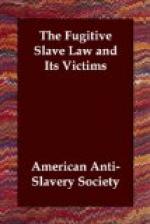the house of one Chapman, “three miles
south of Selma, in Greene county.”
There Chapman and the other, (whose name was William
McCord,) fell upon the colored man, struck him
with a colt upon the head, so that he
bled severely, and bound his hands behind him.
“Soon after the negro got loose and ran down
the road; McCord ran after him, crying ’Catch
the d——d horse thief,’
&c., Chapman and his son following; negro picked up
a stone, the man a club and struck him on the
head, so that he did not throw the stone.
He was then tied, and helped by McCord and Chapman
to walk to the buggy. McCord asked Chapman,
the son, to accompany him to Cincinnati with the colored
man, promising to give him half the reward ($200) if
he would. They then started, driving very
fast.” “We had not gone over
two or three miles,” said Chapman, “before
the negro died, and after taking him two or three
miles further, put him out, and left him as now
discovered,”—viz. in a thick
wood, one mile south of Clifton. The above facts
are taken from the testimony given at the coroner’s
inquest over the body. “The jury gave
in substance the following verdict:—Deceased
came to his death by blows from a colt and club
in the hands of one William McCord, assisted by the
two Chapmans.” Chapman, the son, said that
McCord made him a proposition to join and follow
kidnapping for a business, stating that he knew
where he could get four victims immediately.
McCord was taken and lodged in Xenia jail.
The Chapmans bound over to take their trial for kidnapping.—Wilmington
(Ohio) Herald of Freedom.
Columbus, Indiana. A Kentuckian endeavored to entice a little negro boy to go with him, and both were waiting to take the cars, when mischief was suspected, and a crowd of people proceeded to the depot, and made the kidnapper release his intended victim. (June, 1854.)—Indiana Free Democrat.
—— BROWN, a resident of Henderson, Kentucky, was arrested for aiding four female slaves to escape from Union County, Kentucky, to Canada. United States Marshal Ward and Sheriff Gavitt, of Indiana, made the arrest. He was lodged in Henderson jail.—Evansville (Ind.) Journal, June 2, 1854.
Several Kentucky planters,
among them Archibald Dixon, raised
$500 in order to secure
Brown’s conviction and sentence to
penitentiary.
[Transcriber’s
note: The following note appears as a footnote
to this section without
specific reference to any of the
cited cases.]
—> The case of SOLOMON NORTHUP, though not under the Fugitive Law, is so striking an illustration of the power which created that law, and of the constant danger which impends over every colored citizen of the Northern States, fast threatening to include white citizens also, that it must not he passed over without mention. He was kidnapped in 1841, from the State of New York, and kept in slavery twelve years. Two




